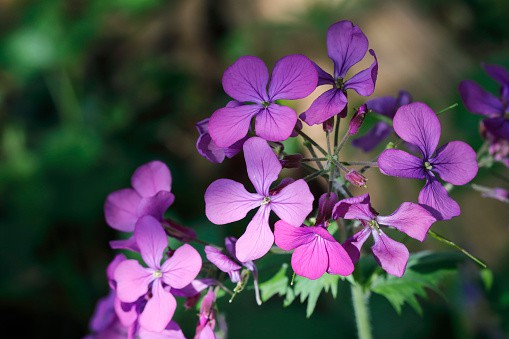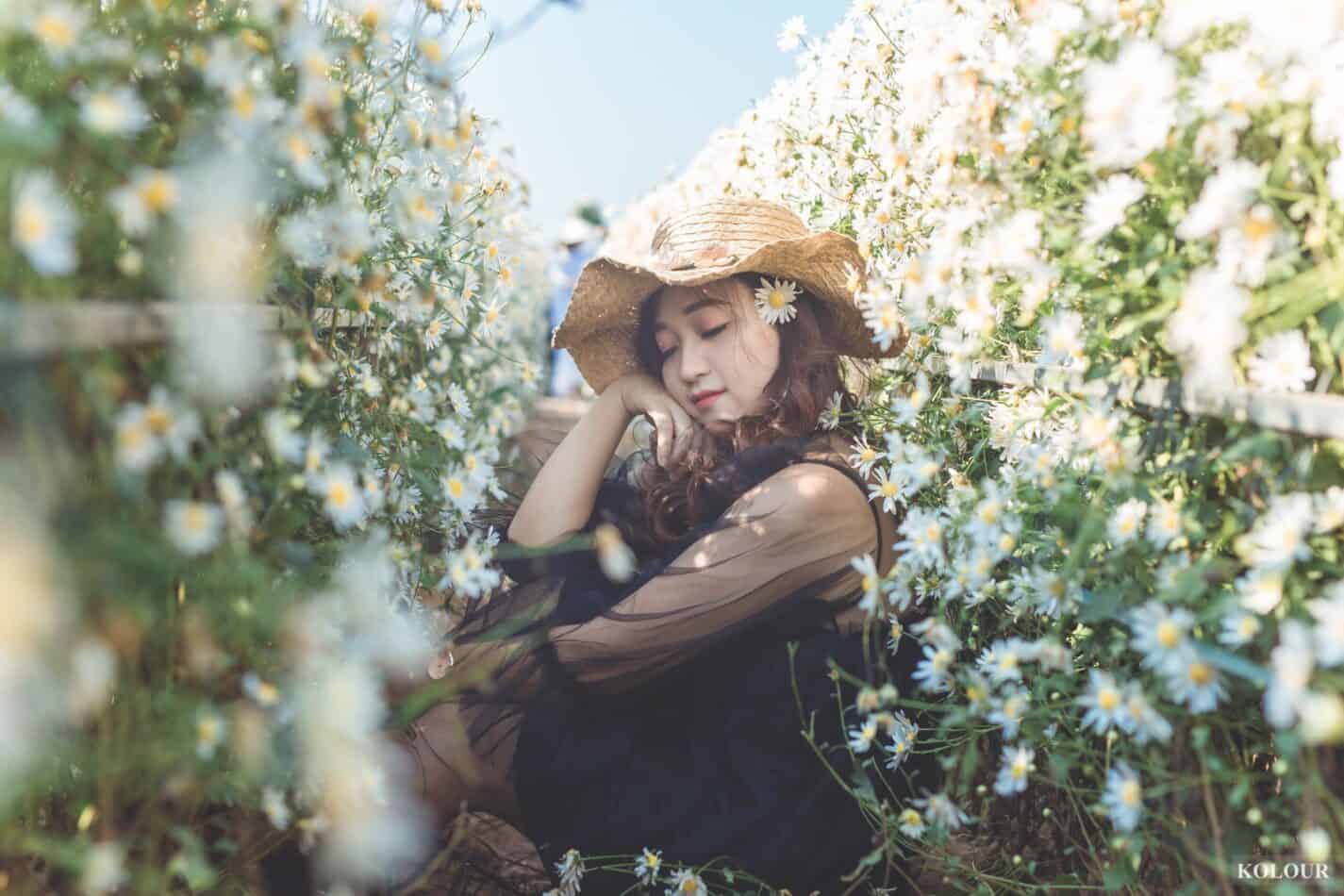The Lunaria annua, commonly referred to as Honesty, is a spectacularly erect biennial flower that produces small and soft lilac blooms, set atop lush green foliage. The blooming period of this flower is rather limited, only a few weeks in mid-spring, after which it is replaced by round and flat seed heads of a silver color, which has earned it its nickname “Silver Dollar”. In recognition of their aesthetical appeal, the Lunaria annua has received the prestigious RHS Garden Merit Award.
The Lunaria annua is a member of the Brassicaceae family. This genus is classified as a biennial, meaning that it has a two-year lifecycle and goes from being a seed to flowering within two years. It also has a native range in temperate regions of Europe.
How to Plant
The Lunaria annua is a moderately easy-to-care flower that prefers sunny to partly shaded climates, meaning 4 to 6 hours of direct sunlight a day, but can also adapt to full shade if necessary. It can grow in almost any kind of soil, from acidic to alkaline, provided it is well-drained and rich in nutrients, with a pH range of 6.0 to 7.5. It thrives in cooler climates, such as in USDA zones 4 all the way to 8. This flower is a great choice both for outdoor settings such as gardens and plots or for indoor use in pots and containers. With an ideal temperature of 17 to 21 degrees Celsius and plenty of atmospheric moisture and humidity, the Lunaria annua thrives with ease.
Due to their biennial lifecycle, the Lunaria annua should be replanted every spring after the winter season, either in the same location if the conditions are still suitable or in a new area. In terms of irrigation, the Lunaria annua should be watered regularly, and more abundantly during periods of drought, remembering to avoid waterlogging.
Meaning and Symbolism
The Lunaria annua is a strong symbol of renewal and renewal of hope. Its scientific name comes from the Latin word “lunaris”, referring to the moon, which is often associated with eternity and the idea of cycles renewing themselves for eternity. It is also widely seen as a symbol of honesty, both in its colours and its physical form, as the flower originates in a pod and slowly reveals itself, just like honesty slowly reveals itself in any situation.
History, Mythology and Religious Significance
The Lunaria annua has always been deeply valued and appreciated in many cultures, particularly the Greco-Roman and Chinese cultures. Ancient Greeks associated the Lunaria annua with the moon goddess, Artemis, and it was regarded as a symbol of honesty and truthfulness. It was also seen as a form of protection that kept bad spirits away. In Christianity, the “honesty” of this flower symbolized Christian virtues, such as humility and especially modesty.
In China, the Lunaria annua was an important cultural symbol, representing “The Mountain of Jade”. The Lunaria annua has also been used in Chinese medicine, as it is believed to possess beneficial qualities, due to its high levels of certain vitamins and minerals.
Flower Varieties and their Defining Characteristics
The Lunaria annua is known by a few different names, including Money Plant, Silver Dollar, and Bigelow’s Lunaria. It’s known for its large and slightly yellow-green foliage, silvery-white seed heads and pink-toned flowers. The flowering period for this flower is typically from late spring to early summer, after which time the plant goes into dormancy and produces the seed heads. It’s best sown in colder climates as it can withstand temperatures of up to -20 degrees Celsius.
The Lunaria annua is also known for its ability to propagate easily and freely. It can spread via either the seed heads it produces or via asexual methods such as cuttings and division. The easiest option is to let it spread naturally, as it requires little care and maintenance and often pops up by itself in gardens and containers.
How to Pot and Repot
Pots and containers are an ideal setting for Lunaria annua. Normal to large-sized pots are recommended. Whereas clay and plastic pots are good choices, and they’re also easy to maintain. When it comes to soil, it is best to use pre-prepared soil, rich in essential nutrients, ensuring that the soil is not overly-acidic. In terms of positioning, it’s best to keep their pots in shady areas, as the Lunaria annua does not thrive in full-heat during the summer.
If you’re looking to repot the Lunaria annua, the safest bet is to do it when the plant is in its resting phase, after it has shed its flower heads and is near dormancy. This process should be done quite carefully as Lunaria annua may not survive if left in a wet condition for very long. However, it can be done with patience and proper care.
How to Prune
Pruning a Lunaria annua is an important part of its care. It’s a good idea to trim the foliage after it has finished flowering in mid-spring as this will help encourage and promote a more abundant bloom in the following season. It’s also a good idea to remove any dead or damaged foliage as this can have a detrimental effect on the health of the plant. Pruning Lunaria annua should not be overly aggressive and should be done with care, using a pair of sterilized pruning sheers.
How to Propagate
Propagating a Lunaria annua is rather straightforward. You can do this either by cuttings or by division. When taking cuttings, ensure you only use healthy and green growth, then simply remove the lower set of leaves and place the cutting in a pot of good quality, well-draining compost. When dividing the plant, use a sharp and clean knife to gently separate the two halves, being sure to leave a good amount of soil on each side. Once divided, re-pot into new containers with good compost and place them in optimum conditions: bright light to shade, with plenty of moisture, and a temperature around 21°C degrees.
Common Pests and Diseases
Lunaria annua is prone to a few pests and diseases. It can be affected by aphids, which can feed on the sap and weaken the plant. To protect your Lunaria annua from these pests, you can check the leaves and stems for signs of infestation, and then employ a natural or chemical predator or insecticidal soap.
In terms of diseases, the Lunaria annua is susceptible to powdery mildew and root rot, which can cause damage to the leaves and weakens the plant. To prevent this, ensure that the Lunaria annua has enough ventilation and is not over-watered. Any diseased areas should be cut away, and a fungicide should be used after the proper application instructions.
Three Frequently Asked Questions About Lunaria Annua
Q: What type of environment does Lunaria annua need?
A: Lunaria annua needs a temperate climate and 4 to 6 hours of direct sunlight a day. It needs well-drained, nutrient-rich soil with a pH range from 6.0 to 7.5. An ideal temperature for the plant is between 17 to 21 degrees Celsius, with plenty of atmospheric moisture and humidity.
Q: How do I propagate Lunaria annua?
A: You can propagate Lunaria annua either via cuttings or division. To propagatevia cuttings, ensure you only use healthy and green growth, then simply remove the lower set of leaves and place the cutting in a pot of good quality, well-draining compost. When dividing the plant, use a sharp and clean knife to gently separate the two halves, making sure to leave a good amount of soil on each side. Once divided, re-pot in new containers with good compost and place them in optimum conditions.
Q: How often should I prune my Lunaria annua?
A: It’s best to trim the foliage after it has finished flowering in mid-spring as this will help encourage and promote a more abundant bloom in the following season. It’s also a good idea to remove any dead or damaged foliage as this can have a detrimental effect on the health of the plant. Pruning Lunaria annua should not be overly aggressive and should be done with care, using a pair of sterilized pruning sheers.
Table Fact Sheet
| Honesty | Lunaria Annua |
|---|---|
| Family | Brassicaceae |
| Plant Type | Biennial |
| Mature Size | 0.6m (24in) |
| Sun Exposure | 4-6 hours |
| Soil Type | Well-drained, Nutrient-rich Soil |
| Soil pH | 6.0-7.5 |
| Bloom Time | Late Spring-Early Summer |
| Flower Color | Pink-Toned |
| Hardiness Zones | 4-8 |
| Native Area | Temperate Regions of Europe |
What we love from Amazon this week
Buy these wonderful flowers directly from Amazon:















